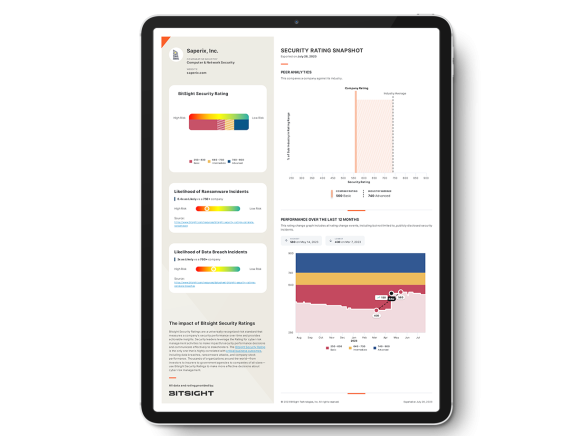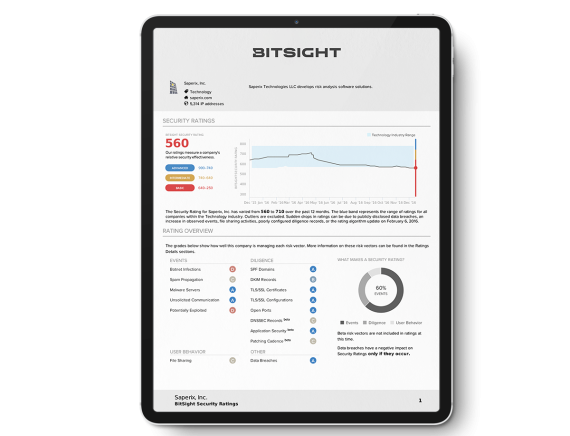Request a free executive report, which includes your security rating, for your company to find the gaps in your security program and how you compare to others in your industry.

Now more than ever before, it’s critical to build a strategic security performance management program in which you take a risk-based, outcome-driven approach to measuring, monitoring, managing, and reporting on your organization’s cybersecurity program performance over time. Of course, in order to do so, you need an easily understandable framework through which you can conduct a cyber risk analysis and lead meaningful conversations on the business impact of your organization’s risk exposure.
That’s where financial quantification comes in — empowering you to provide data-driven risk quantification insights that make sense to business stakeholders.
Proven quantification models developed for cyber insurance
To bridge the language gap between security and the business, mature cybersecurity leaders are turning towards analyzing cyber risk in the same way the organization looks at other issues: in terms of its financial impact. But traditional financial quantification approaches lead to long, complex projects that aren’t easily repeatable due to the time, effort, and outside resources required to collect the necessary data.
With Bitsight Financial Quantification for Enterprise Cyber Risk, you can quantify your cyber risk financially without investing in any additional headcount. The offering simulates your organization’s financial exposure across multiple types of cyber events and impact scenarios to calculate a range of potential financial losses.
The world's largest insurance and reinsurance carriers use the underlying models that drive the Bitsight Financial Quantification. This process involves assessing multiple types of losses (attritional losses, large losses, and catastrophe losses) as well as multiple types of events (specific events and systemic events). Leveraging these evolving cyber risk models enables underwriters and exposure managers to efficiently price risk. In fact, this process is used to manage billions of dollars of cyber exposure today.
Request your personalized executive & security rating report

Request your personalized executive & security rating report
A faster, more streamlined quantification process
Developing a mature program in today’s evolving cybersecurity landscape requires a constant flow of high-quality, validated data that assesses how both your organization’s security posture and the threat landscape are changing over time.
While traditional financial quantification methods often rely on consulting engagements or long data collection processes, the Bitsight Financial Quantification is available on-demand, is easily repeatable, and can be run without adding any headcount. With the ability to drill down into cyber event examples — including damage types and other relevant data — security and risk management leaders can diagnose the underlying causes that impact financial exposure in a faster, more streamlined way than ever before.
The solution combines technographic data, firmographic data, cyber insurance claims data, and cyber scenario probability calculations to quickly and easily simulate your organization’s financial exposure across multiple types of business impact scenarios, including:
- Denial of service incidents
- Ransomware and extortion attacks
- Data theft and privacy
- Third-party service provider failures
- Regulatory compliance issues
- Third-party liability
As this turnkey solution builds off of existing Bitsight data, you can implement it quickly and easily — without investing in any additional resources.
The results of the modeling process are displayed in an exceedance probability (EP) graph, which shows the probability for suffering different financial losses from cyber events — broken down by impact scenario and overall magnitude of exposure. These calculations on the potential financial damage are produced based on an understanding of two factors: how it will affect the business (i.e., liability, business interruption) and the parameters of the event in question (i.e., duration, intensity, what’s affected).
Provide cyber risk analysis insights in business context
Armed with data-driven context into your organization’s probable maximum loss, you can drive strategic conversations around which risks to accept, mitigate, or transfer — and make cybersecurity investment decisions based on what’s best for the business.
Interested in learning more about how the Bitsight Financial Quantification makes it easier than ever to provide cyber risk analysis insights in a language that makes sense to non-technical stakeholders? Check out our ebook, Establishing a Universal Understanding of Cyber Risk With Financial Quantification.
Request your personalized security rating report

Request your personalized security rating report
Request your free Security Rating Snapshot for your company to find the gaps in your security program and how you compare to others in your industry.